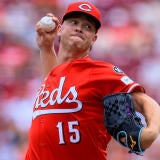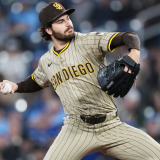2019 Fantasy Baseball Draft Prep: Watch your WHIP in Rotisserie leagues
Trying to balance WHIP with pitching counting stats can be tricky and impact your roster construction. Heath Cummings looks at winning strategies.
Want to get a jump on the competition? Go to the CBS Sports app on your phone, open up "Settings" and sign up for Fantasy alerts to get the latest from our Fantasy baseball team as soon as it's available.
One of the great challenges of Rotisserie baseball is balancing your ratios (ERA and WHIP) with your counting stats (wins and strikeouts). It's become even more interesting as teams lean more on relievers earlier in games and the number of reliable 200-inning starting pitchers shrinks.
When it comes to specifically analyzing WHIP, you're looking for pitchers who keep hitters off base. But it's not just as simple as looking at who did it best last year, because pitchers don't control every part of the equation. They can control walks and strikeouts to a certain extent and should have some control over keeping the ball in the park. Base hits are a little bit trickier.
When you're analyzing your team's WHIP it comes down to how many early picks you dedicate to aces. If you land two or three of the top-20 starting pitchers, you may be fine with three closers and six starting pitchers. If you go hitter-heavy early in the draft, it's going to be much more difficult to produce good ratios with that many questionable starting pitchers, and you may want to consider someone like Josh Hader as a ratio-specialist.
One strategy that's underused is going reliever-heavy early in the year and then picking your spots with two-start streamers throughout the second half to make up ground in wins. As long as you hit on a couple of guys like Hader and Edwin Diaz, you may even have enough strikeouts with a four-man starting rotation.
Whatever you do, you don't want to ignore WHIP and find yourself in a hole. The difference between first and 11th (0.15) doesn't seem like much, but it's a mountain to climb once you've accumulated a few months worth of innings.
2018 Leaders
- Justin Verlander - 0.90
- Max Scherzer - 0.91
- Jacob deGrom - 0.91
- Blake Snell - 0.97
- Aaron Nola - 0.97
- Corey Kluber - 0.99
- Gerrit Cole - 1.03
- Patrick Corbin - 1.05
- Miles Mikolas - 1.07
- Zack Greinke, Mike Foltynewicz - 1.08
What you need to win
Below you'll find the average number of WHIP by place for the category in 2018. These number are for a standard, mixed, 12-team league. In an eight- or 10 team league, these numbers would be higher. In a 15-team league you could aim lower.
Place | WHIP |
1st | 1.18 |
3rd | 1.22 |
5th | 1.25 |
7th | 1.28 |
9th | 1.30 |
11th | 1.33 |
Sleeper
Yusei Kikuchi joins the Seattle Mariners after eight wildly successful seasons in Japan. Kikuchi owns a career 2.81 ERA with a 1.17 WHIP, but he really took a leap over the last two seasons. In 350 innings he's walked just 94 batters and struck out more than a batter per inning. While it would be unfair to expect numbers quite that good in his first major league action, his improved control gives him potential for a low WHIP.
Kikuchi has above-average velocity for a left-handed pitcher and uses three additional pitches. There is some concern about his innings as he adjusts to a major league schedule, but that's less of a concern in Rotisserie. He may also be a slightly below-average strikeout pitcher, but you can live with that if his ADP lands anywhere close to his consensus ranking of 253 overall.
Breakout
Nick Pivetta's ERA suggests a terrible year in 2018. His WHIP wasn't particularly good either. And yet:
2018 SP w/
— Heath Cummings (@heathcummingssr) January 16, 2019
>27% K%
>46% GB%
Jacob deGrom
Aaron Nola
Patrick Corbin
Carlos Carrasco
German Marquez
Nick Pivetta
Simply put, Pivetta was one of the least fortunate pitchers in baseball. Some of that could be traced to command problems (.326 BABIP, 15.8 percent HR/FB rate) or trouble pitching out of the stretch (69 percent strand rate). But if you have a 12 percent swinging strike rate and seven percent walk rate, you should be a good pitcher and you should have a borderline-great WHIP.
Bust
You might look at Julio Teheran's WHIP and ERA from 2018 and think that he solved his control problems from 2017. Nothing could be further from the truth. Teheran walked a career-worst 4.3 batters per nine innings. He also gave up 1.33 HR/9, which was the second-highest mark of his career.
So how did he post an ERA below four? Mostly dumb luck. Hitters only had a .217 BABIP against him, which is a full 51 points below his career average. And that was despite the fact Teheran gave up more hard contact than he ever has in his career.
I wouldn't want Teheran anywhere near my mixed-league roster.
AL-Only Target
When you get into the depths of league-specific drafts, you start choosing between mediocre starting pitchers and good middle relievers. If you're worried about your ratios, the reliever is almost always the way to go.
Adam Ottavino is a very good (great?) middle reliever who signed with the Yankees this offseason. He's posted a WHIP of 0.99 and 0.93 in two of his past three seasons. In 2018 he had his best strikeout year, whiffing 36 percent of the batters he faced.
Being a Yankee will give Ottavino an extra boost in holds leagues, as he figures to be among the league leaders.
NL-Only Target
Like Ottavino, Tony Watson is one of those relievers who can have a big impact in Roto without saves. Watson has a career 1.08 WHIP and has bested that mark in five of the past six seasons. He pitches half of his games in a big park and has closing experience if the Giants' current plans don't pan out. Watson should be a solid bet for good ratios and even more valuable if he repeats last year's 26 percent strikeout rate.



























